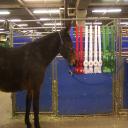Yahoo Answers is shutting down on May 4th, 2021 (Eastern Time) and beginning April 20th, 2021 (Eastern Time) the Yahoo Answers website will be in read-only mode. There will be no changes to other Yahoo properties or services, or your Yahoo account. You can find more information about the Yahoo Answers shutdown and how to download your data on this help page.
Trending News
counter canter problems?
My mare will move out in the counter canter no problem, but the minute I ask her to move in, she either falls apart to a trot or lead changes. I am glad for the good lead changes, lol, but counter canter comes before lead changes in dressage, so we need to learn it.
My cues in a loop: to X- push over with outside (on wall) leg and rein, to wall- push over with inside leg and rein. I am using a lot of outside leg to push her over, IF she goes at all before breaking.
Her canter is very balanced and her counter canter moving out is excellent, but if I ask her to move in- she just falls apart.
Should I be using different aids or any exercises that can strengthen moving to the inside with the counter canter? Should I be turning her head into or out of the loop or let her place it wherever?
3 Answers
- MulereinerLv 71 decade agoFavorite Answer
Do you carry a riding crop, you need to enforce more forward motion when the turns get tight.
I'm sure you can feel when she is going to break down, so when that happens, push with your seat and legs, if she still breaks down or no response, then pop on the rear with the crop.
I would work on lots of shoulder ins and outs to supple the horse too, lots of tight circles at first.
Then move into a canter and work on more shoulder ins and outs, but keep working on your counter canter, I think the mare is realizing its harder work to counter canter tighter and is just breaking down on you.
Good luck!
- 1 decade ago
Why are you asking her to "move in?" She's probably breaking because that's unbalancing her. The way I trained counter canter to my horse didn't involve any lateral work within the counter canter (obviously I had to teach him tons of lateral work before hand...). We just went down the long side at the trot, then I asked him to pick up the canter on the opposite lead, so that when we went around the corner he'd be in counter canter. That requires your horse to be really attentive to your aids, rather than just anticipating and picking up the inside lead. An easier way to get into it is just to canter normally on a circle then just cross the diagonal... you said your horse might do lead changes too... that's because you're not keeping your weight to the inside of her bend. if you let your weight shift even a little to the outside, that's a cue for the change. I read in an article that the counter canter is not difficult for the horse, it's only as difficultas the rider makes it. So just keep your weight to the inside of your horse's bend, with your inside seatbone leading a little, but keep her head in the middle, between her shoulders, but with enough inside rein contact so that you can see her inside eye a little. Try doing more lateral work exercises before you keep training the counter canter. This will strengthen your horse's hind end and esp. inside leg, and make her more responsive to your aids. Try switching between shoulder-in, renvers, leg yield, and travers at the walk on a 20 m circle. You can try these at the trot too. Another helpful exercise: shoulder-in down the longside, at E or B, a 10 m circle in shoulder-fore, then after the 10 m., travers down the longside.
oh! I just realized- I couldn't understand what you meant by a "loop." You must be talking about a broken line! Now I see that your problem with changes/ trotting really is from you not keeping your weight in the correct place. So, say you're heading down the longside, you've just passed A, and you're going to the left. You're on the left lead canter. Then at F, move toward x, (but only go as far as the quarter line), then once you reach the quarter line, make a shallow turn and head back toward M, staying on the left lead the whole time. So when you're making that turn, she's in the counter canter for only a few strides. It's important to stay straight, except for those few strides in the middle. Don't leg yield anywhere in that exercise! That's incorrect, and why you're having problems. hope that helps...
- Anonymous1 decade ago
The aid for counter canter is that your legs remain the same as a true canter so.... inside leg on at the girth and outside leg slightly behind the girth and you should just open your inside rein to steer.
The horse should be bent to the inside as per normal and just steer rather than changing the postiton of your legs. and keep your weight in your inside seat bone.
Source(s): professional rider and equine dentist


